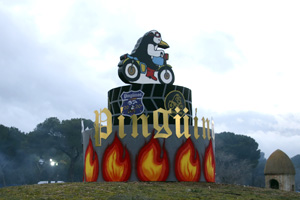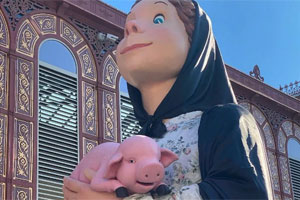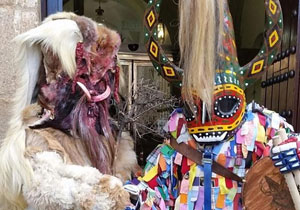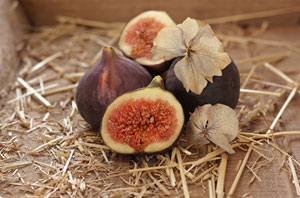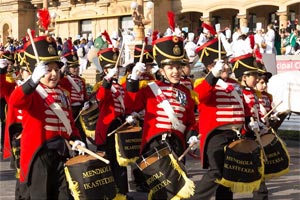Water Monday in Salamanca
How Lunes de Aguas is celebrated
The "Lunes de Aguas" is a deep-rooted tradition in Salamanca, and has already spread to many parts of the province. This celebration takes place on the Monday following Easter Sunday, and its origins date back to the 16th century.
It is a pagan festival as it has nothing to do with the Lenten season and is celebrated after the end of Holy Week. It is also the time when the people of Salamanca eat the hornazo.
Its origins are peculiar and it is worth stopping to scrutinise how mischievous history can sometimes be, as the reason for this festival is the celebration held by the large student community for the return of the prostitutes to the city.
Nowadays, people gather with friends and family to enjoy a picnic in the open air and spend a day of relaxation and fun in the countryside. One of the typical foods eaten on this festival is hornazo, a pie filled with chorizo, pork loin and boiled egg.
Origin and History of Lunes de Aguas
The Lunes de Aguas in Salamanca has its roots in the 16th century, when Prince Philip II arrived in the city to marry Princess Maria of Portugal (in 1543). During his stay, the prince observed the city's coexistence of scholarship and recreation, as Salamanca at that time had more than 8,000 students and a large number of people working around them.
Due to the many temptations that surrounded the students, Felipe II decided to enact ordinances requiring that prostitutes living in the Casa de Mancebía had to be taken out of the city during Lent to avoid the sin of lust. These women were brought back to the city on the first Monday after Easter by Father Putas, a character who guarded them during their stay outside the city.
On this day, the students celebrated the arrival of the prostitutes with a big party on the banks of the river Tormes, where they consumed hornazos, drinks and danced in decorated boats. Thus, Lunes de Aguas became a festivity that combined religious tradition with the celebration of the arrival of the prostitutes in the city.
Where to eat the hornazo on Lunes de Aguas?
The tradition is to eat it in the countryside or on the banks of the river Tormes. In any case, there are favourite places to eat it, where people tend to gather.
In Salamanca, the best places to eat hornazo are:
- Near the Roman Bridge.
- In the Aldehuela.
- Along the riverside promenade.
- In Salas Bajas.
- In Huerta Otea.
- In Würzburg Park.
- On the Isla del Soto.
- Valcuevo Park, very close to Salamanca on the Ledesma road.
The Hornazo
Its origins date back to the Middle Ages, when it was a common food among shepherds who spent long periods in the countryside, as it was nutritious and easy to preserve. Over time, it became a traditional dish in the region's festivals, such as Lunes de Aguas, and has remained to this day one of the most popular meals in the whole of Castile.
Recipe for hornazo from Salamanca
Ingredients
- 400 ml. milk
- 300 g. lard
- 150 gr. of pressed yeast, also known as baker's yeast
- 400 ml. of boiled olive oil
- Flour, as much as you can take according to the preparation (approximately one and a half kilos)
- 6 egg yolks
- A pinch of salt
Filling, the quantities to be chosen by the person preparing the dish or by the diners
- Boiled egg
- Chorizo sausage
- Serrano ham
- Loin in fillets or stuffed
Preparation
In a bowl, mix the milk, the oil (cold), and add the salt, dissolving it. Add the butter and knead until it softens. Then add the yeast, dissolving it very well because it is important that there are no lumps. Then add the egg yolks and continue mixing. Add as much flour as you can, but not too much so that the dough does not crack.
Once the dough is ready, it is time to divide it in 2 and roll each one out with a rolling pin until it is about 3mm thick. Enough to cover a tray of about 30×40 cm. Place the first layer on a baking tray, on top of it the filling in layers of materials and on top of that the second layer of dough. Close the edges tightly and brush the surface of the top layer with beaten egg. Prick it in several places with a fork so that air escapes during baking and there is no hollow inside.
Place the tray in a preheated oven at 210ºC for 45 to 50 minutes.
What to see in Salamanca
Salamanca is a city with an impressive wealth of monuments, as well as a great cultural and gastronomic offer. Some of the places not to be missed are the Plaza Mayor, the University, the New and Old Cathedral, the Casa de las Conchas, the Convent of San Esteban, the Clerecía, the Huerto de Calixto y Melibea, and the Barrio del Oeste, among others. You can also sample the local gastronomy in its bars and restaurants, try the Iberian ham, cheese, wine from the Toro Designation of Origin and, of course, the famous hornazo.

